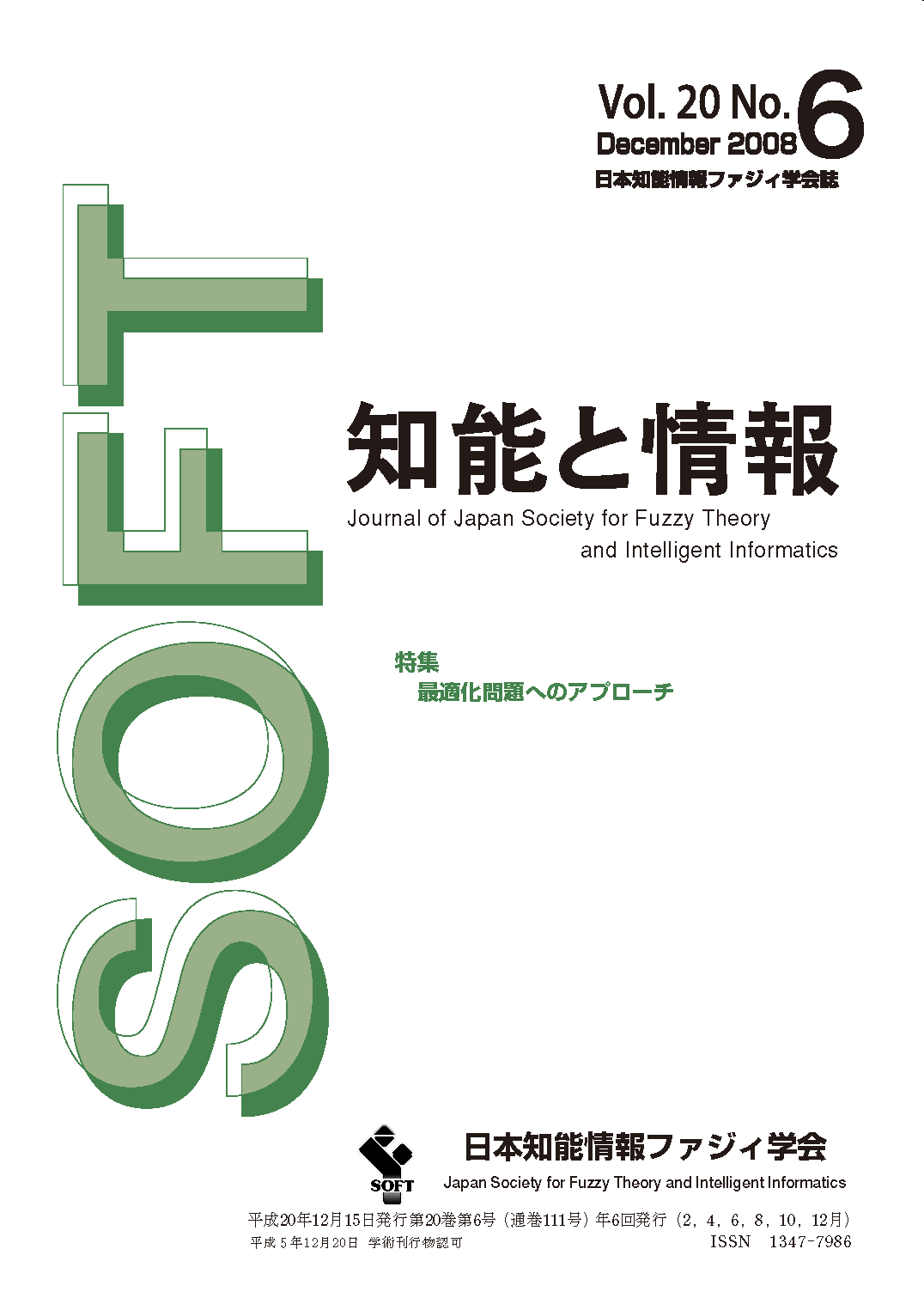Volume 20, Issue 6
Displaying 1-26 of 26 articles from this issue
- |<
- <
- 1
- >
- >|
-
2008 Volume 20 Issue 6 Pages toc-
Published: December 15, 2008
Released on J-STAGE: February 04, 2018
Download PDF (152K)
-
2008 Volume 20 Issue 6 Pages 827
Published: December 15, 2008
Released on J-STAGE: February 04, 2018
Download PDF (128K)
-
2008 Volume 20 Issue 6 Pages 828
Published: December 15, 2008
Released on J-STAGE: February 04, 2018
Download PDF (136K)
-
2008 Volume 20 Issue 6 Pages 829-839
Published: December 15, 2008
Released on J-STAGE: February 04, 2018
Download PDF (1077K)
Special Issue: Approaches to Optimization Problems
Original Papers
-
2008 Volume 20 Issue 6 Pages 840-849
Published: December 15, 2008
Released on J-STAGE: May 22, 2009
Download PDF (659K) -
2008 Volume 20 Issue 6 Pages 850-859
Published: December 15, 2008
Released on J-STAGE: May 22, 2009
Download PDF (1111K) -
2008 Volume 20 Issue 6 Pages 860-871
Published: December 15, 2008
Released on J-STAGE: May 22, 2009
Download PDF (1042K) -
2008 Volume 20 Issue 6 Pages 872-882
Published: December 15, 2008
Released on J-STAGE: May 22, 2009
Download PDF (914K)
-
2008 Volume 20 Issue 6 Pages 883-890
Published: December 15, 2008
Released on J-STAGE: February 04, 2018
Download PDF (500K) -
2008 Volume 20 Issue 6 Pages 891-903
Published: December 15, 2008
Released on J-STAGE: February 04, 2018
Download PDF (1312K)
-
2008 Volume 20 Issue 6 Pages 904-905
Published: December 15, 2008
Released on J-STAGE: February 04, 2018
Download PDF (659K)
-
2008 Volume 20 Issue 6 Pages 906
Published: December 15, 2008
Released on J-STAGE: February 04, 2018
Download PDF (124K)
-
2008 Volume 20 Issue 6 Pages 907
Published: December 15, 2008
Released on J-STAGE: February 04, 2018
Download PDF (120K) -
2008 Volume 20 Issue 6 Pages 907
Published: December 15, 2008
Released on J-STAGE: February 04, 2018
Download PDF (120K)
-
2008 Volume 20 Issue 6 Pages 908
Published: December 15, 2008
Released on J-STAGE: February 04, 2018
Download PDF (207K)
Regular
Original Papers
-
2008 Volume 20 Issue 6 Pages 909-920
Published: December 15, 2008
Released on J-STAGE: May 22, 2009
Download PDF (882K) -
2008 Volume 20 Issue 6 Pages 921-933
Published: December 15, 2008
Released on J-STAGE: May 22, 2009
Download PDF (962K) -
2008 Volume 20 Issue 6 Pages 934-943
Published: December 15, 2008
Released on J-STAGE: May 22, 2009
Download PDF (1416K) -
2008 Volume 20 Issue 6 Pages 944-951
Published: December 15, 2008
Released on J-STAGE: May 22, 2009
Download PDF (433K) -
2008 Volume 20 Issue 6 Pages 952-962
Published: December 15, 2008
Released on J-STAGE: May 22, 2009
Download PDF (1671K) -
2008 Volume 20 Issue 6 Pages 963-971
Published: December 15, 2008
Released on J-STAGE: May 22, 2009
Download PDF (537K)
R&D Papers
-
2008 Volume 20 Issue 6 Pages 972-980
Published: December 15, 2008
Released on J-STAGE: May 22, 2009
Download PDF (518K)
-
2008 Volume 20 Issue 6 Pages 981-984
Published: December 15, 2008
Released on J-STAGE: February 04, 2018
Download PDF (363K) -
2008 Volume 20 Issue 6 Pages 985
Published: December 15, 2008
Released on J-STAGE: February 04, 2018
Download PDF (133K) -
2008 Volume 20 Issue 6 Pages alltoc-
Published: December 15, 2008
Released on J-STAGE: February 04, 2018
Download PDF (334K)
-
2008 Volume 20 Issue 6 Pages bulletin-
Published: December 15, 2008
Released on J-STAGE: February 04, 2018
Download PDF (272K)
- |<
- <
- 1
- >
- >|
